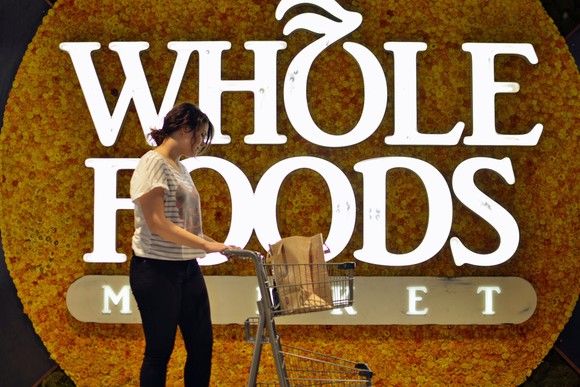Whole Foods gives it a foothold in grocery, but it will help sell Prime memberships, too.
Amazon.com (NASDAQ:AMZN) has made waves across the grocery industry after offering to buy Whole Foods Market (NASDAQ:WFM) for $13.7 billion in cash. Amazon will soon have a foothold in both grocery and brick-and-mortar retail after the deal closes (expected in the second half of the year). The company has been slowly moving toward establishing a larger presence in both over the last half-decade or so.
Adding Whole Foods’ 464 stores gives Amazon a major platform to expand its online grocery ordering and delivery service, where it competes with Wal-Mart and local delivery companies like Instacart. It could also help attract even more customers to Amazon Prime, Amazon’s loyalty program that includes unlimited two-day shipping and streaming video, among other benefits.
The grocery industry is massive
Grocery stores generated over $600 billion in revenue last year. What’s more, food and beverages are necessities, so while there will always be price competition in this market, it’s not like the bottom is ever going to drop out of those sales.
Wal-Mart is the country’s largest grocer, with over 50% of its sales coming from the category. In 2015, the company started moving into online grocery ordering in select markets. It quickly expanded to over 100 markets and 670 stores in 2016.
Wal-Mart’s existing stores have allowed it to expand its online grocery ordering service extremely quickly. In comparison, Amazon’s Prime Fresh service is available only in a handful of markets after launching a full decade ago. Adding Whole Foods Market to its arsenal provides both a fulfillment source and pickup spot for online grocery orders for Amazon, giving customers the option to enroll in a delivery service like Prime Fresh or pick up orders for free, like with Wal-Mart’s model.
Orders are moving online. About one-quarter of American households already buy at least some groceries online, according to a report from Food Marketing Institute and Nielsen. The research firms expect 70% of shoppers will buy groceries online in the next decade and 60% of consumers will spend at least a quarter of their at-home food budgets online. Overall, online grocery ordering could be a $100 billion industry unto itself by 2025.
“Alexa, add avocados to my shopping list”
The Whole Foods acquisition also offers a compelling reason to actually use Amazon’s personal assistant, Alexa, for shopping lists. Alexa is built into all of Amazon’s hardware, from its Echo smart speakers to the Fire TV to its tablets. Combined with Amazon’s artificial intelligence (AI) capabilities and Whole Foods locations, it could result in a very convenient way to order groceries. Offering Prime members the option to have someone go and pick out everything on your shopping list for you, to have ready to pick up at your local Whole Foods, while automatically charging your Amazon account would make for an extremely convenient grocery ordering system.
Amazon will surely use Whole Foods as a way to sell more of its hardware and sign up more members to Amazon Prime. The above is just one example of how it could achieve that goal. Ultimately, Amazon CEO Jeff Bezos wants every household in America to become a Prime member. Adding a touch point that consumers will visit on a weekly (if not more frequent) basis should make Prime more appealing.
More Prime signups translates into more sales on Amazon’s online marketplace, as Prime members are incentivized to start their product search on Amazon.com thanks to its two-day shipping benefit. Last year, more than half of consumers started their online product search on Amazon.com, and that number continues to climb as more and more customers sign up for Prime.
Whole Foods provides yet another avenue for Amazon to add value to Prime and Alexa. It’s not just a way for Amazon to establish itself in the grocery space, but a means to strengthen its complete dominance of online retail.
10 stocks we like better than Amazon
When investing geniuses David and Tom Gardner have a stock tip, it can pay to listen. After all, the newsletter they have run for over a decade, Motley Fool Stock Advisor, has tripled the market.*
David and Tom just revealed what they believe are the ten best stocks for investors to buy right now… and Amazon wasn’t one of them! That’s right — they think these 10 stocks are even better buys.
*Stock Advisor returns as of July 6, 2017
John Mackey, CEO of Whole Foods Market, is a member of The Motley Fool’s board of directors. Adam Levyowns shares of Amazon. The Motley Fool owns shares of and recommends Amazon and Whole Foods Market. The Motley Fool has a disclosure policy.














